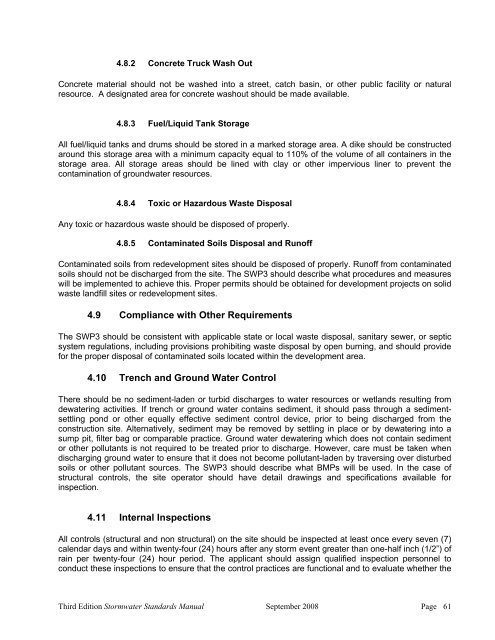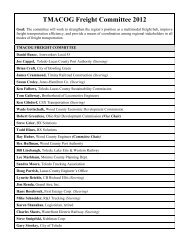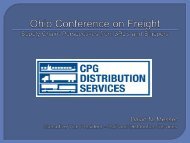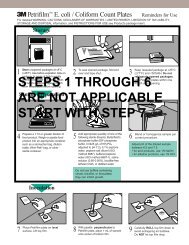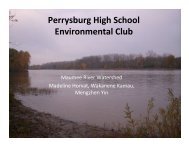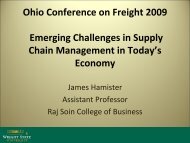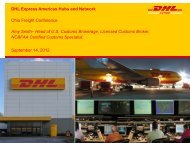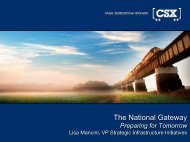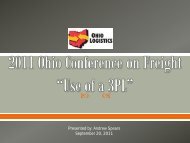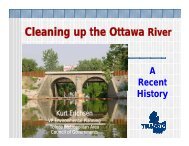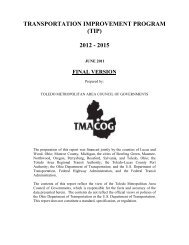Stormwater Management Standards Manual - Toledo Metropolitan ...
Stormwater Management Standards Manual - Toledo Metropolitan ...
Stormwater Management Standards Manual - Toledo Metropolitan ...
You also want an ePaper? Increase the reach of your titles
YUMPU automatically turns print PDFs into web optimized ePapers that Google loves.
4.8.2 Concrete Truck Wash Out<br />
Concrete material should not be washed into a street, catch basin, or other public facility or natural<br />
resource. A designated area for concrete washout should be made available.<br />
4.8.3 Fuel/Liquid Tank Storage<br />
All fuel/liquid tanks and drums should be stored in a marked storage area. A dike should be constructed<br />
around this storage area with a minimum capacity equal to 110% of the volume of all containers in the<br />
storage area. All storage areas should be lined with clay or other impervious liner to prevent the<br />
contamination of groundwater resources.<br />
4.8.4 Toxic or Hazardous Waste Disposal<br />
Any toxic or hazardous waste should be disposed of properly.<br />
4.8.5 Contaminated Soils Disposal and Runoff<br />
Contaminated soils from redevelopment sites should be disposed of properly. Runoff from contaminated<br />
soils should not be discharged from the site. The SWP3 should describe what procedures and measures<br />
will be implemented to achieve this. Proper permits should be obtained for development projects on solid<br />
waste landfill sites or redevelopment sites.<br />
4.9 Compliance with Other Requirements<br />
The SWP3 should be consistent with applicable state or local waste disposal, sanitary sewer, or septic<br />
system regulations, including provisions prohibiting waste disposal by open burning, and should provide<br />
for the proper disposal of contaminated soils located within the development area.<br />
4.10 Trench and Ground Water Control<br />
There should be no sediment-laden or turbid discharges to water resources or wetlands resulting from<br />
dewatering activities. If trench or ground water contains sediment, it should pass through a sedimentsettling<br />
pond or other equally effective sediment control device, prior to being discharged from the<br />
construction site. Alternatively, sediment may be removed by settling in place or by dewatering into a<br />
sump pit, filter bag or comparable practice. Ground water dewatering which does not contain sediment<br />
or other pollutants is not required to be treated prior to discharge. However, care must be taken when<br />
discharging ground water to ensure that it does not become pollutant-laden by traversing over disturbed<br />
soils or other pollutant sources. The SWP3 should describe what BMPs will be used. In the case of<br />
structural controls, the site operator should have detail drawings and specifications available for<br />
inspection.<br />
4.11 Internal Inspections<br />
All controls (structural and non structural) on the site should be inspected at least once every seven (7)<br />
calendar days and within twenty-four (24) hours after any storm event greater than one-half inch (1/2”) of<br />
rain per twenty-four (24) hour period. The applicant should assign qualified inspection personnel to<br />
conduct these inspections to ensure that the control practices are functional and to evaluate whether the<br />
Third Edition <strong>Stormwater</strong> <strong>Standards</strong> <strong>Manual</strong> September 2008 Page 61


